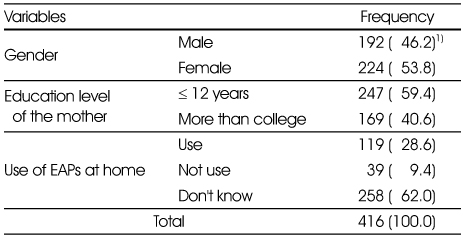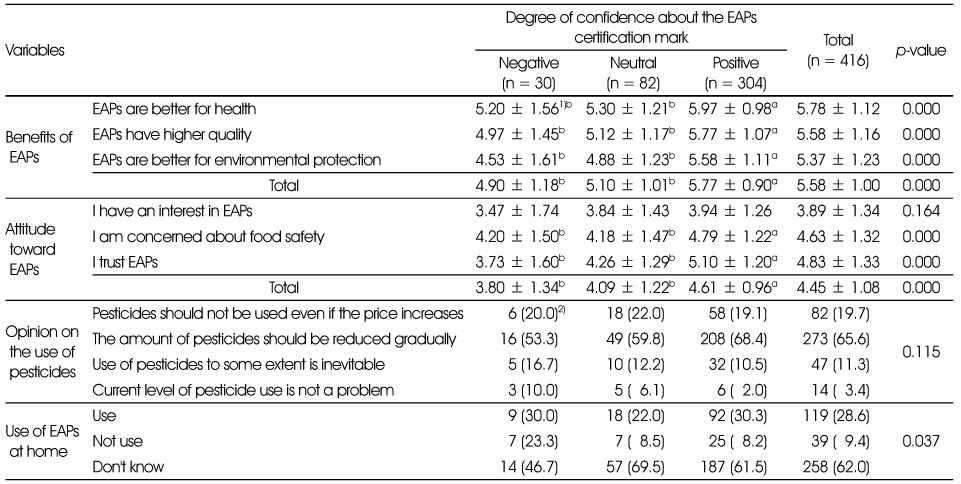Articles
- Page Path
- HOME > Korean J Community Nutr > Volume 18(4); 2013 > Article
-
Original Article
- Middle School Students' Perception of Environment-friendly Agricultural Products (EAPs) and the Degree of Confidence about the Certification Mark in Daegu
- Ji-Yeon Jang, Mi-Kyung Choi
-
Korean Journal of Community Nutrition 2013;18(4):324-332.
DOI: https://doi.org/10.5720/kjcn.2013.18.4.324
Published online: August 31, 2013
Department of Nutrition Education, Graduate School of Education, Keimyung University, Daegu, Korea.
1Department of Food and Nutrition, Keimyung University, Daegu, Korea.
- Corresponding author: Mi Kyung Choi, Department of Food and Nutrition, Keimyung University, Daegu 704-701, Korea. Tel: (053) 580-5872, Fax: (053) 580-5885, mkchoi@kmu.ac.kr
Copyright © 2013 The Korean Society of Community Nutrition
This is an Open-Access article distributed under the terms of the Creative Commons Attribution Non-Commercial License (http://creativecommons.org/licenses/by-nc/3.0/) which permits unrestricted non-commercial use, distribution, and reproduction in any medium, provided the original work is properly cited.
- 986 Views
- 0 Download
Abstract
- The purpose of this study was to investigate middle school students' perception of environment-friendly agricultural products (EAPs) and the degree of confidence about the certification mark. Questionnaires were distributed to 444 students of 6 middle schools located in Daegu, and a total of 416 responses were used for analysis. 28.6% of the respondents were using EAPs at home, and 62.0% of respondents didn't know whether to use EAPs at home. The 6 items representing the perception of EAPs were analyzed, resulting in 2 distinct dimensions-'benefits of EAPs' and 'attitude toward EAPs'. Regarding Benefits of EAPs, the score of 'EAPs better for health' was the highest, followed by 'EAPs have higher quality', 'EAPs were better for environmental protection', respectively. The proportion of students responded that 'the amount of pesticides should be reduced gradually' was 65.5% and only 3.4% for 'current level of pesticide use is not a problem'. There were significant differences between male and female students with regard to an interest in EAPs (p < 0.05) and opinion on the use of pesticides (p < 0.05), while no significant difference was found between groups with different education level of mothers. The respondents who use EAPs at home showed significantly higher scores with attitude toward EAPs (p < 0.001), and higher response rate for 'pesticides should not be used even if the price increases' (p < 0.05). Degree of confidence about the EAPs certification mark also affected students' perception of EAPs (p < 0.001). Our results indicate the importance of education for students on EAPs to enhance students' attitude towards EAPs and improve school meal satisfaction.
- 1. Chang HS, Lee MJ. The perception for management of school foodservice using of environmentally friendly agri-cultural products of elementary school children's mothers in Gunsan. Korean J Community Nutr 2008; 13(6): 867-878.
- 2. Choi MK, Seo HC, Baek SH. The influence of environment-friendly agricultural products (EAPs) perception of parents in Chung-buk area on EAPs consumption behavior. Korean J Food Nutr 2010; 23(2): 269-275.
- 3. Ducan DW, Broyles TW. An evaluation of student and perceptions toward agriculture before and after attending a governor's school for agriculture. J Southern Agric Educ Res 2004; 54(1): 280-292.
- 4. Hong YG, Song IS. A study of cases of ethical consumption in the analysis of purchasing motives of environmnetally-friendly agriculture products. Consumption Cult Study 2008; 11(3): 23-42.
- 5. Honkanen P, Verplanken B, Olsen SO. Ethical values and motives driving organic food choice. J Consumer Behav 2006; 5(5): 420-430.Article
- 6. Jeong JH, Kim EJ, Kim MH, Choi MK. Perception of eco-friendly agricultural products and food service satisfaction of elementary and middle school students according to eco-friendly food service day in Chungnam. J Korean Soc Food Sci Nutr 2013; 42(1): 114-119.Article
- 7. Joshi A, Azuma AM, Feenstra G. Do farm-to-school programs make a difference? Findings and future research needs. J Hunger Environ Nutr 2008; 3(2): 229-246.Article
- 8. Kim IJ, Lee JH. The housewives' purchase behaviors on environment-friendly agricultural products in Daejeon area. Korean J Community Nutr 2011; 16(3): 386-397.Article
- 9. Kim NR, Cho YS, Kim SA. Satisfaction and recognition level of environment-friendly agricultural products in Cheongju area. Korean J Community Nutr 2011; 16(1): 75-85.Article
- 10. Kim SH, Jeong DW, Kim GH. Analysis of the relationship among image, awareness, public confidence of certificate mark for environment-friendly agricultural products, and purchase intention. J Foodserv Manage 2012; 15(6): 359-383.
- 11. Kim SO, An KW, Kim MH, Shim JH. Evaluating some influential factors on consumers' purchasing decisions of environment-friendly agricultural products (EAPs) using importance-performance analysis (IPA). Korean J Org Agric 2007; 15(4): 339-353.
- 12. Kim SS. A study on consumer's attitude for food safety and purchase of environment friendly agricultural products. J Korean Home Manage Assoc 2007; 25(6): 15-32.
- 13. Kwak MJ, Kim KN. Perception and consumption of Environment-friendly farm products (EP) among the parents of children in the schools where EP had been used or never been used in their foodservice. J Hum Ecol 2012; 16(1): 85-94.
- 14. Lee SH, Han SB, Do HO, Seo KD. The effect of hallmark of the environment friendly agricultural products on the consumer value and purchase intention: Centering around the moderating effect of regulatory focus and construal level. Digit Policy Res 2011; 9(4): 143-156.
- 15. Lee YS, Lee NO, Ko SH. A survey on use of environment-friendly agricultural products for school food service by dietitians in Chungnam province. Korean J Community Nutr 2009; 14(5): 556-564.
- 16. Lee YS, Park MJ. Parental perception and satisfaction with environment-friendly agricultural products used for school foodservice in elementary schools in Daejeon. Korean J Food Cult 2008; 23(6): 737-747.
- 17. Magnusson MK, Avrola A, Hursti UK, Aberg L, Sjödén PO. Choice of organic foods is related to perceived con-sequences for human health and to environmentally friendly behaviour. Appetite 2003; 40(2): 109-117.PubMed
- 18. Michaelidou N, Hassan LM. The role of health consciousness, food safety concern and ethical identity on attitudes and intentions towards organic food. Int J Consum Stud 2008; 32(2): 163-170.
- 19. Ministry of Education, Science and Technology. Instructions for student health promotion 2012. Seoul: Ministry of Education, Science and Technology; 2012. p. 34-45.
- 20. National Agricultural products quality management Services. Agricultural products standardization management. 2012; cited 2013 April 20]. Available from http://www.naqs.go.kr.
- 21. Oh YM, Kim MH, Sung CJ. Effects of school lunch program on nutritional knowledge and attitude, and dietary behavior of Korean middle school students. Korean J Community Nutr 2005; 10(2): 163-173.
- 22. Ryu JH, Rho JO. The consumption behavior and perceptions of environment-friendly agricultural products by university students in Korea. Korean J Food Nutr 2011; 24(1): 101-110.
- 23. Ryu MJ, Suh JS, Lyu ES. A perception of dietitians for using imported foods and pro-environment farm products for elementary school foodservice operations in Busan. J Korean Diet Assoc 2004; 10(4): 452-466.
- 24. Sung MJ, Choi HS, Chang KJ. Perceptions on environment and environment-friendly agricultural products of college students in Seoul and Incheon area. J Korean Soc Food Sci Nutr 2008; 37(3): 317-324.
- 25. Yang IS, Cha JA, Shin SY, Park MK. Foodservice management. 2nd ed. Paju: Kyomunsa; 2008. p. 38-46.
REFERENCES
Figure & Data
REFERENCES
Citations

General characteristics of respondents
1) N (%)
Validity and reliability of the measure
Perception of EAPs
1) Mean ± SD, Likert style 7 point scale: 'Not at all' (1), 'Strongly agree' (7)
Opinion on the use of pesticides
1) N (%)
Degree of confidence about the EAPs certification mark
1) N (%)
The association of perception on EAPs and use at home
1) Mean ± SD, Likert style 7 point scale: 'Not at all' (1), 'Strongly agree' (7)
2) N (%)
ab: Values with different superscripts within a row are significantly different as assessed by the Scheffe's multiple range test (p < 0.05).
The association of perception on EAPs and degree of confidence about the EAPs certification mark
1) Mean ± SD, Likert style 7 point scale: 'Not at all' (1), 'Strongly agree' (7)
2) N (%)
ab: Values with different superscripts within a row are significantly different as assessed by the Scheffe's multiple range test (p < 0.05).
1) N (%)
1) Mean ± SD, Likert style 7 point scale: 'Not at all' (1), 'Strongly agree' (7)
1) N (%)
1) N (%)
1) Mean ± SD, Likert style 7 point scale: 'Not at all' (1), 'Strongly agree' (7) 2) N (%) ab: Values with different superscripts within a row are significantly different as assessed by the Scheffe's multiple range test (
1) Mean ± SD, Likert style 7 point scale: 'Not at all' (1), 'Strongly agree' (7) 2) N (%) ab: Values with different superscripts within a row are significantly different as assessed by the Scheffe's multiple range test (

 KSCN
KSCN







 Cite
Cite


